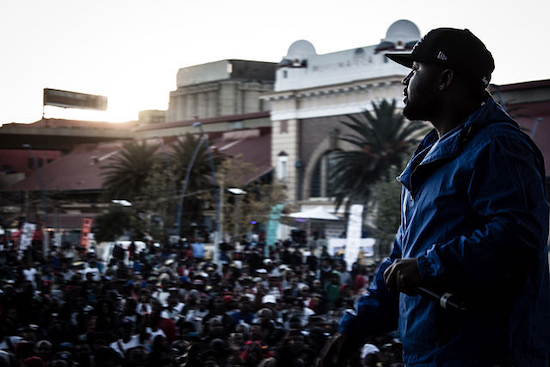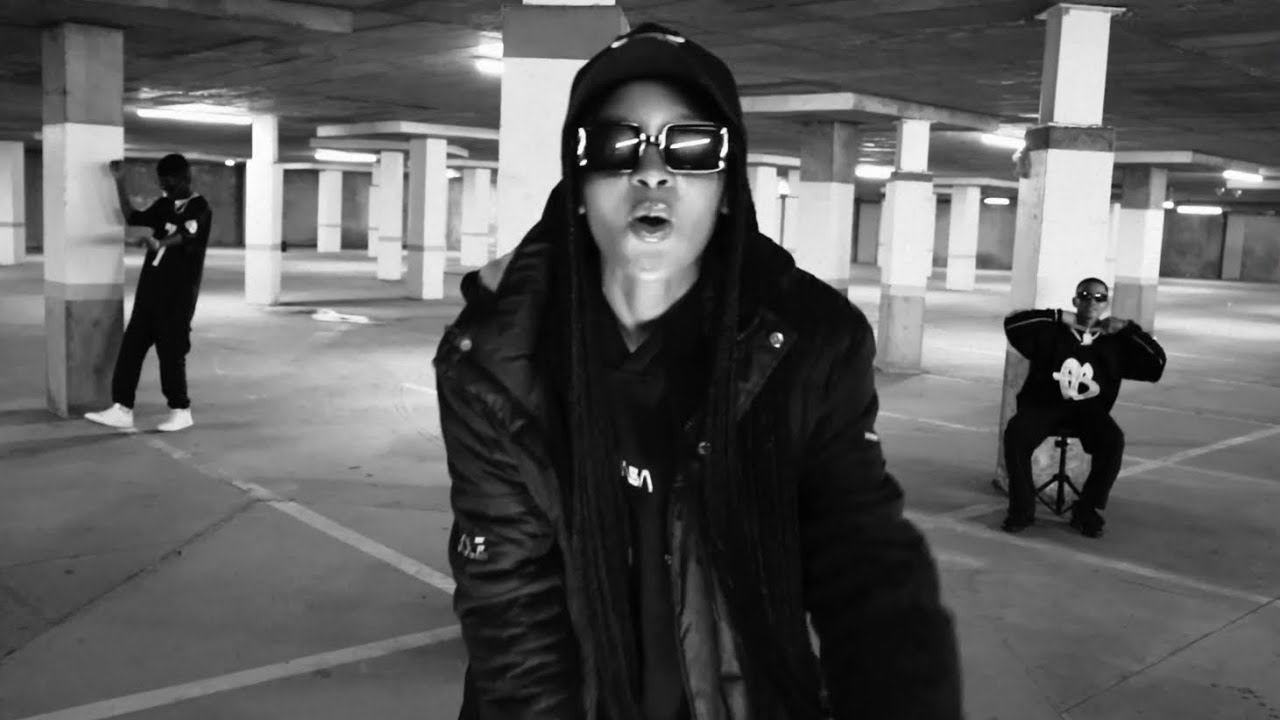Cassper Nyovest, photo via Wikimedia Commons
The nature of Modern Content necessitates digging through an algorithmically generated landslide falling from every sheer face of the internet in order to find that Feeling—that cosmic smack, the seismic sizzle of something both new and somehow familiar. And at some point over the last few years, South African music makers got the memo that originality is crucial. Origins are crucial. Even if you’re borrowing and patchworking from other worlds, it’s the specifics that really pull in a listener, that inspire a universal feeling out of a personal experience.
South Africa has been a major player in recent movements in hip hop, electronic music, and pop – Drake teamed with Black Coffee, Beyonce used Uncle Waffles for a dance break on tour, and Tyla just became the first South African to hit the Billboard Hot 100 chart in the US in more than 50 years. The confluence of all those moments can be found in amapiano and gqom, differently shaded electronic subgenres that are now as likely to be found in Boiler Room mixes as in rap beats.
And much the way those styles build in part out of house and footwork which in turn built from African American experimentation, South African rappers are adding a new layer to the evolution, developing their own new sub-subgenre that fuses elements of those styles with another import: drill.
The Chicago-born rap style proliferated quickly, bringing its low-BPM menace, distorted bass, trap hi-hats, and terse rhymes, and setting up outposts from Brooklyn to Brixton. But for a genre centred on young Black people detailing the harsh realities they faced every day, South Africa makes for another logical foothold. The country is still feeling the vicious shadow of apartheid: young Black people theoretically given an equal playing field after the policy was struck down but coming up against decades’ worth of infrastructure still stacked against them.
Every element of South African culture is formed from composite parts: 12 official languages, countless more tribal cultures, a deeply rich history including a horrific spectre of racial oppression. And even beyond the aural distinctions between the different languages and pronunciations, the many different tribal rhythmic and melodic traditions have held sway in varying degrees across genres.
And yet there are threads unifying large swathes of the country’s music of late, particularly with the international rise of amapiano and gqom – and that’s true in drill as well. There are already clear ties between the skittering percussion of both amapiano and drill, but some artists are leaning further, breathing more and more of the jazzy synth and airy production of amapiano, or the claustrophobic rhythmic looping of gqom into drill to create a new take on drill. Others, meanwhile, are leaning hard on the tradition, emphasizing the stark worldview.
The scene is also a perfect reminder of the depth and diversity of the South African music world. While interest in “world music” led to acts like Ladysmith Black Mambazo touring the globe, the gut reaction to the phrase “South African music” for so many over the last decade and a half has been “Die Antwoord”. But within their home country, their “zef” working class kitsch-ploitation was an outlier. And as the years go by, the shock value they provided seems to be wearing off globally. If listeners are looking for something more real, more grounded, then drill may provide precisely that – with the South African scene providing a polylithic take rooted in the country’s many-faceted cultural landscape.
As evidenced by this list, the depth and breadth of the South African rap world is due a reassessment from the international community. And those won over here should check out the Space Impaxt podcast on Youtube for more, as their in-depth interviews with young artists document the scene beautifully.
The following are ten fascinating examples of South African artists evolving trap and drill, a welcoming rubric to a familiar and strange new scene.
Cassper Nyovest feat. Maglera Doe Boy – ‘018’
Cassper Nyovest has been one of the biggest names in South African rap for more than a decade, and is widely considered one of the best MCs on the continent. And yet rather than rest on his laurels, Cass continues evolving through flares of gqom and amapiano. On the lead single from 2023’s Solomon, he and rising artist Maglera Doe Boy tap into the rising South African drill tide. True to the genre’s origins, the track is named after the phone code that unites the “hard streets and trenches” of their North West province hometowns (per producer Huey Ozyl). But those streets are very different from Chicago (“Township, that’s the new Gaza” is a fiery bar), and the frenetic interplay between the duo’s voices and hopping between languages is a fascinating step away from the slow, choppy lines of Chief Keef.
Asianwokstar – ‘TMS’
Chief Keef hasn’t exactly been topping the charts in the last few years, but his shadow looms as large in Johannesburg today as any international artist. “Sosa. That’s where I get most of my inspiration from”, Asianwokstar said in an interview with Space Impaxt – although it doesn’t take a whole lot of listening to pick that out. But the MC’s name should also indicate that he’s working at the everything-at-once postmodern speed of a younger generation of rapper. His take on drill glitches and burns with gqom energy, the percussion clicking and popping, layers of sample and bass overlapping and crowding the frame. The weighty darkness of classic drill is there, but in a far more claustrophobic and charred outlook.
parkervs – ‘youngl0rd’
“I was high as fuck in a Range Rover”, parkervs sighs on ‘youngl0rd’, his bleary eyes practically audible – name-dropping what seems to be the ultimate vehicular status symbol of late in SA’s drill scene. The scene is very collaborative and connected, and parker is situated deep. In addition to his producer compatriot ethnvs, he’s supposed to have a full tape of collaborations with Asianwokstar coming and has featured with BrotherKupa and Don Earl among others. Like Wok, parkervs’ beats tend towards the inescapable-swarm-of-angry-synth-bees style, every inch of the canvas painted a few times over. But parker’s voice is mixed higher, drips with AutoTune, and opts for energetic crackle rather than low-slung intensity.
BrotherKupa – ‘Potion 2’
"The music I make, I don’t think it fits for this country,” Kupa told Space Impaxt – and while it’s true that he doesn’t lean as heavily into crowded electronics or gqom and amapiano stylings, he’s doing himself a disservice with that assessment. It’s fitting that his flow at times reminds of a Chicagoan: Lucki, offering the cloudy counterpart to the barking and sneering. The beats are slower, heavier, and psychedelic, the kind of stuff suited for a night stuck in the couch with some substances or a slow drive through a dark city street.
gl0ckst4r*777x feat. Jaykatana – ‘TOP DOG’
A big part of the development of kwaito – and then gqom and amapiano after that – came from Black South Africans finally being able to invent their own language and future at the end of apartheid. The sort of drill being put out by artists like gl0ckst4r*777x demonstrates futurism in the shifting and panning synth wobbles, but also a razor-edged present in the lyrics. On ‘TOP DOG’, gl0ck and fellow drill star Jaykatana lean on the lean, talk their business, and even shoot their shot with Drake’s favorite, Uncle Waffles. Though he may be very difficult to properly Google, gl0ckst4r has the confidence of someone with high ranking results.
Offshore – ‘Ladder’
It’s as if Pretoria’s Offshore is pulling drill apart at the seams. The skittering beats and sub-bass are separated out to individual milliseconds and left to drift out into space, with a dash of soul and R&B added into the mix. It certainly fits his floating voice and soft-spoken delivery, as on the icy and mysterious ‘Ladder’. There the percussive samples scurry and pan, like being sent off into a bad trip. The track feels like getting paranoid in the middle of the night, a more intimate drill but no less dark.
Babylowsk1 – ‘Bring It Back’
There are heavy dance elements to Babylowsk1’s ‘Bring It Back’, the track landing somewhere between mosh pit and dancefloor thanks to the rising and falling stair steps of sub-bass. The song starts at 11 and only builds from there, the quick-looped sampling making every few seconds start like a new notch being ratcheted up. Similar to its Chicago origins, there’s a real youth movement energy to the South African drill scene, and the timbre of Babylowsk1’s voice fits that vibe perfectly.
Jaykatana – ‘Eish!’
"Right now I believe that we can actually take over music”, Jay said in an interview with Faneto on Youtube. It’s no wonder he seems to be SA rapper’s SA rapper at the moment, pushing hard for global attention for the whole scene. He may be more tapped into the Destroy Lonely and Playboi Carti R&B intensity and trap churn than the straight drill world, but Jay’s scorching delivery on tracks like “Eish!” (a classic bit of South African slang, a yelping surprise) carry the torch well. “Black drip like I’m Undertaker,” he spits, an echoed laugh turned into a percussive synth blast.
Scumie – ‘JIT/SRT’
Scumie rides the line between what you might expect from drill and trap, but a track that hits as hard as the first half of ‘JIT/SRT’ surely qualifies. "I ain’t talking all that shit/ I’m going to tell you right now bitch you ain’t be shit/ I been chillin, trying to buy a 30-round clip”, she seethes, the second half of the track finding her more laid back. While they never rose to the prominence of a Keef or a Lil Durk, female rappers like Sasha Go Hard and Katie Got Bandz were dropping some of the most exciting stuff in Chicago’s early drill days. Scumie may be outnumbered by the fellas both on this list and in the scene in general, but her contributions should not be slept on – and with an appearance on an Uncle Waffles album, that’d be hard to do anyway.
Iceb0y feat. Babylowsk1 – ‘x em out’
While one wave of South African drill uses its tight loops to fill every breathable inch with claustrophobic sound, Iceb0y works well when the concentric circles start to feel like portals into outer space. On the BrotherKupa-produced ‘x em out’, the start-stop beat lets him showcase both the punchy syllables and the AutoTuned sing-song, while Babylowsk1 twitches through the beat.







